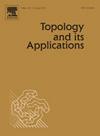关于对角线度和星形网络
IF 0.6
4区 数学
Q3 MATHEMATICS
引用次数: 0
摘要
给定拓扑空间 X 的开盖 U,我们引入 U 的星形网络概念。相关的心形函数 sn(X)(其中 e(X)≤sn(X)≤L(X) )用于建立涉及对角度的新心形不等式。我们证明了 T1 空间 X 的 |X|≤sn(X)Δ(X),部分回答了安杰洛-贝拉(Angelo Bella)的一个长期问题。利用 sn(X) 的变化给出了许多进一步的结果。其中一个结果的推论是布扎科娃(Buzyakova)的定理,即具有规则 Gδ 对角线的ccc 空间的心性至多为 c,以及哥切夫(Gotchev)的三个结果。进一步的结果导致了巴西尔、贝拉和里德博斯定理的逻辑改进,同一作者的一个问题的部分解答,以及哥切夫、特卡琴科和特卡丘克的一个定理。最后,我们定义了具有 Ue(X)≤min{aL(X),e(X)} 特性的乌里索恩程度 Ue(X),并使用厄尔多斯-拉多定理证明了对于任何乌里索恩空间 X,|X|≤2Ue(X)Δ‾(X)。本文章由计算机程序翻译,如有差异,请以英文原文为准。
On diagonal degrees and star networks
Given an open cover of a topological space X, we introduce the notion of a star network for . The associated cardinal function , where , is used to establish new cardinal inequalities involving diagonal degrees. We show for a space X, giving a partial answer to a long-standing question of Angelo Bella. Many further results are given using variations of . One result has as corollaries Buzyakova's theorem that a ccc space with a regular -diagonal has cardinality at most , as well as three results of Gotchev. Further results lead to logical improvements of theorems of Basile, Bella, and Ridderbos, a partial solution to a question of the same authors, and a theorem of Gotchev, Tkachenko, and Tkachuk. Finally, we define the Urysohn extent with the property and use the Erdős-Rado theorem to show that for any Urysohn space X.
求助全文
通过发布文献求助,成功后即可免费获取论文全文。
去求助
来源期刊
CiteScore
1.20
自引率
33.30%
发文量
251
审稿时长
6 months
期刊介绍:
Topology and its Applications is primarily concerned with publishing original research papers of moderate length. However, a limited number of carefully selected survey or expository papers are also included. The mathematical focus of the journal is that suggested by the title: Research in Topology. It is felt that it is inadvisable to attempt a definitive description of topology as understood for this journal. Certainly the subject includes the algebraic, general, geometric, and set-theoretic facets of topology as well as areas of interactions between topology and other mathematical disciplines, e.g. topological algebra, topological dynamics, functional analysis, category theory. Since the roles of various aspects of topology continue to change, the non-specific delineation of topics serves to reflect the current state of research in topology.
At regular intervals, the journal publishes a section entitled Open Problems in Topology, edited by J. van Mill and G.M. Reed. This is a status report on the 1100 problems listed in the book of the same name published by North-Holland in 1990, edited by van Mill and Reed.

 求助内容:
求助内容: 应助结果提醒方式:
应助结果提醒方式:


